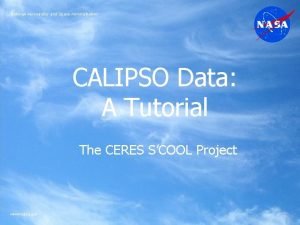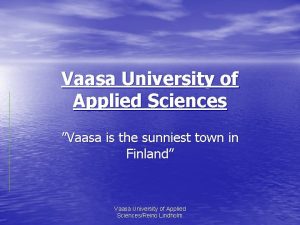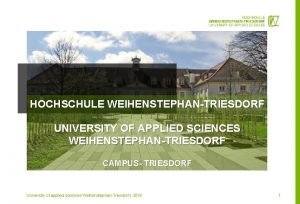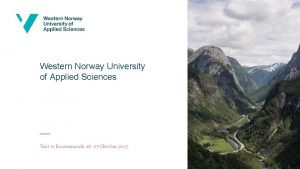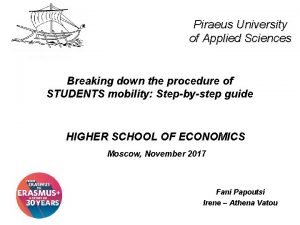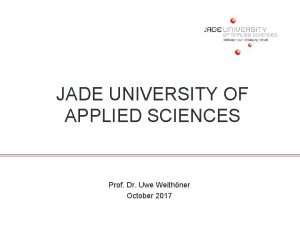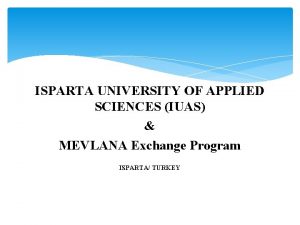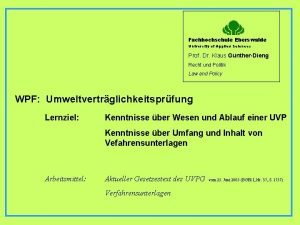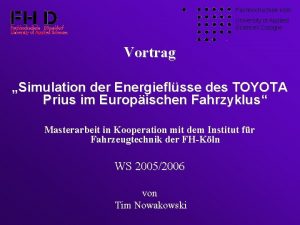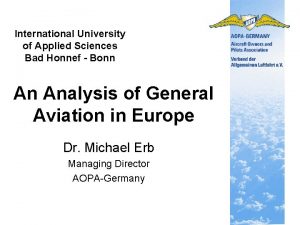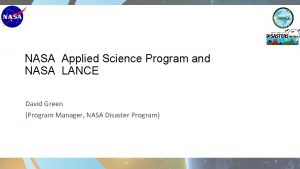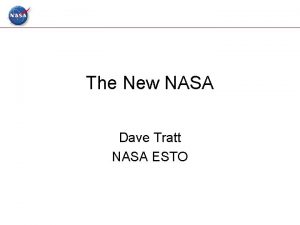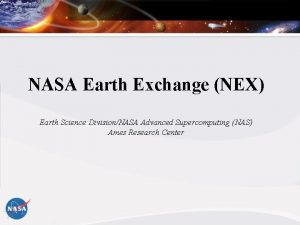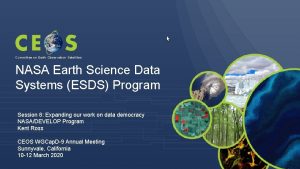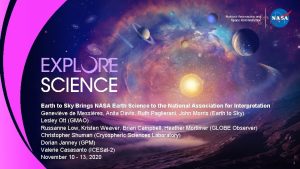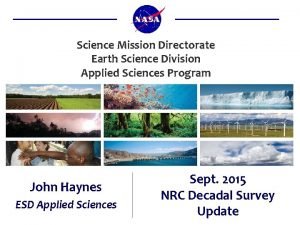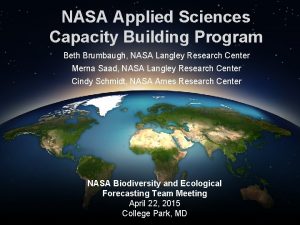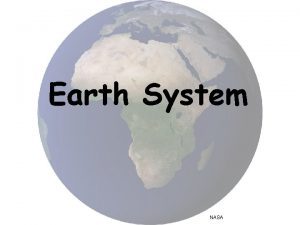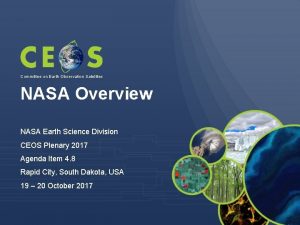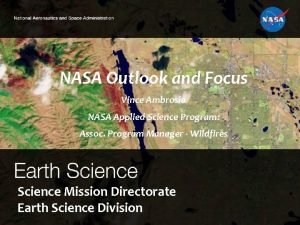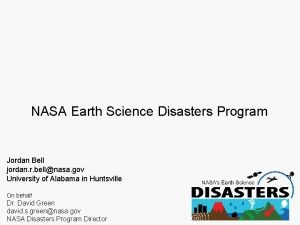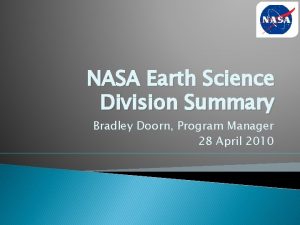NASA Earth Science Applied Sciences Program Applied Sciences















- Slides: 15

NASA Earth Science Applied Sciences Program Applied Sciences Perspective Lawrence Friedl, Program Director LANCE User Working Group Meeting September 2014

|2

2014 NASA Strategic Plan Strategic Goals 1. Expand the frontiers of knowledge, capability, and opportunity in space. 2. Advance understanding of Earth and develop technologies to improve the quality of life on our home planet. 3. Serve the American public and accomplish our Mission by effectively managing our people, technical capabilities, and infrastructure.

Applied Sciences Advisory Committee May 2014 report: A constant and overriding theme throughout our meetings was the growing importance of applications to NASA’s core mission – a natural outcome of NASA’s multi -decade commitment to understanding Earth from space. |4

Applied Sciences Advisory Committee Seven Key Topics to Address » Decadal Survey Ensure applications are an integral part of the upcoming Earth Science Decadal Survey » Mission Planning Fully integrate applications requirements into NASA mission planning early » Data and Mission Planning Include the DAACs and application users as early as possible in the process of mission planning. » Application Adoption Identify the characteristics of successful adoptions of Earth science data into applications. » Tools for Data Access & Use Accelerate the development of tools which improve the ease of use, latency, and continuity of NASA Earth science data for application users. » Communications More effectively communicate the value of applications of NASA data and the accomplishments of ASP both internally and to the American public. » Capacity Building Address the financial allocation within the Capacity Building program |5

Applied Sciences Advisory Committee Successful adoption of Earth science data into applications requires that the user be motivated and the data be accessible, offered in application friendly data formats, and delivered within a decisionable timeframe. – ASAC, 2014 |6

Applied Sciences: Lines of Business Applications in Mission Planning Identify applications early and throughout mission lifecycle, integrate end-user needs in design and development, enable user feedback, and broaden advocacy. Societal & Economic Applications Generate, test, develop, enable adoption, and extol applications ideas for sustained uses of Earth obs. in decisions and actions. Capacity Development Build skills, workforce, and capabilities in US and developing countries to apply Earth obs. to benefit society and build economies. Key Principle: Constant experimentation to figure out how to better inspire applications, ideas, ways to broker, etc. |7

Applications Areas Emphasis in 4 Applications Areas Health & Air Quality Water Resources Disasters Ecological Forecasting Support opportunities in 5 additional areas Agriculture Energy Weather Climate Oceans Also: Cross-cutting Element of Wildfires |8

Earth Science & Applications The national strategy outlined here has as its overarching objective a program of scientific discovery and development of applications that will enhance economic competitiveness, protect life and property, and assist in the stewardship of the planet for this and future generations. Earth Science Decadal Survey |9

What key questions and advancements does the Earth science and applications community need to address in the next 10 -15 years? What key questions – if addressed well or answered – would make major advances in our knowledge and it use in decisions and actions? What are key questions and challenges that address both scientific needs and societal decisions? What can the applicationsoriented communities organize over next 15 months to address these and support the next Earth Science Decadal Survey? | 10

Back-up Materials LANCE User Working Group Meeting September 2014 | 11

NASA Earth Science Technology Flight Missions Research Data Systems NASA Earth Science supports basic and applied research on the Earth system and its processes. Characterize, understand, and improve predictions of the Earth system to advance knowledge and benefit society. Education Applications | 12

Earth Science and Applications Basic Research Applied Research Applications

Inform Decisions & Actions Applied Sciences Program Approach to Integrated System Solutions Earth System Models Land, Atmosphere, Oceans, Cryosphere, Coupled Models Model Products, Data Assimilation, Predictive Capabilities Predictions/ Forecasts High-Performance Computing, Communication, and Visualization Satellite, Airborne, Ground, In-situ Partnership Area Decision Support Systems Assessments Data Earth Observatories & Measurements Value and Benefits to citizens and society Standards and Interoperability Scenario Tools Analysis to support decision-making processes & actions Policy Decisions Management Decisions Observations Missions, Sensors, Data Products Inputs Outputs NASA and Partners Outcomes Impacts Partners with Decision Support Systems | 14

 Applied science vs pure science
Applied science vs pure science Alin sa hanay ng mga sagot ang kahulugan ng bugtong na anak
Alin sa hanay ng mga sagot ang kahulugan ng bugtong na anak Nasa www.nasa.gov
Nasa www.nasa.gov Human sciences tok definition
Human sciences tok definition Van hall larenstein university of applied sciences
Van hall larenstein university of applied sciences Vaasa university of applied sciences
Vaasa university of applied sciences Oulu university of applied sciences
Oulu university of applied sciences Fh triesdorf agrartechnik
Fh triesdorf agrartechnik Kodolanyi janos university (kju)
Kodolanyi janos university (kju) Western norway university of applied sciences
Western norway university of applied sciences Piraeus university of applied sciences
Piraeus university of applied sciences Jade university of applied sciences
Jade university of applied sciences Isparta university of applied sciences
Isparta university of applied sciences Eberswalde university of applied sciences
Eberswalde university of applied sciences Mischhybrid
Mischhybrid International university of applied sciences bad honnef
International university of applied sciences bad honnef


